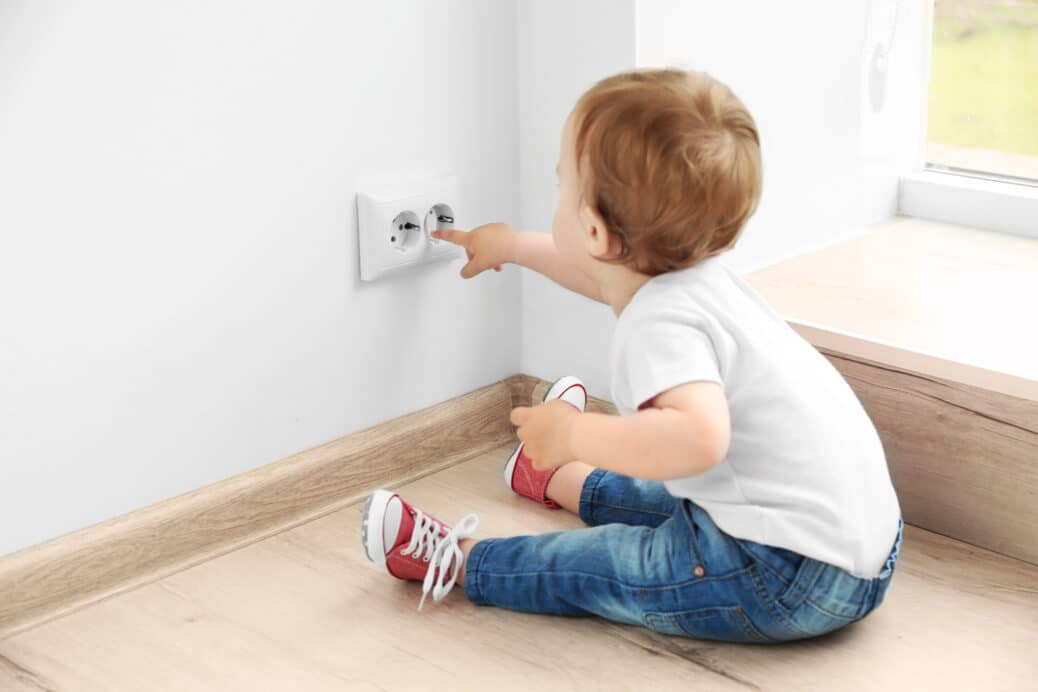Electricity keeps the home running, yet it poses real risks for curious children. Injury data underline the point.
Kidsafe reports that each year more than 150 Australian children die from unintentional injuries and over 68,000 are hospitalised.
Many of these incidents occur at home and are preventable.
The Australian Institute of Health and Welfare tracks electricity injuries across the country. In 2023–24 there were 518 hospital cases involving electricity and air pressure injuries, and in 2022–23 there were 9 deaths, all male.
The numbers are small compared with other hazards, but consequences can be severe, which is why prevention matters.
Start with a safety plan
Walk through each room from a child’s eye level. Note every socket, cord, charger and appliance within reach.
Prioritise places where children spend time, especially bedrooms, lounge rooms and play areas.
Kitchens, bathrooms and laundries add water to the mix, so raise the bar further there.
Sockets and switches
- Fit childproof covers or safety plates on unused sockets. Choose units that fix to the wall or have spring shutters rather than loose plastic caps that can be prised out. “This can provide a permanent solution that ensures these outlets are inaccessible to children” says Mr Emergency.
- Keep furniture clear of sockets you use often. If you must block access, ensure you can still see the socket for signs of heat or damage.
- Replace cracked or discoloured outlets at once. Heat staining, rattling faceplates or buzzing sounds point to a fault.
- Teach children to ask before touching switches. Early habits help.
Residual current devices and your switchboard
Residual current devices, often called safety switches, cut power quickly when they detect a leakage of current. They are an essential layer for families.
- Ensure every circuit in the home has a safety switch. Older homes may have only some circuits protected. A licensed electrician can add protection to remaining circuits.
- Test safety switches every three months using the “Test” button on the switchboard. Power should trip instantly. Reset and test the next one.
- If a switch trips repeatedly, do not ignore it. Unplug recent additions and call a licensed electrician to investigate.
Cords, chargers and power boards
- Keep cords short and out of reach. Use cord shorteners or cable boxes rather than running leads under rugs, which can overheat.
- Choose power boards with overload protection and an on–off switch. Mount them vertically if possible and avoid piggybacking adaptors.
- Park charging hubs on a hard surface with good airflow. Avoid charging on bedding, couches or carpets.
- Store spare button batteries and coin cells well away from children and tape over used ones before disposal. Remote controls and musical cards are common sources.
- Replace damaged cords. Exposed copper, kinks or scorch marks are reasons to bin and replace, not repair with tape.
Kitchens, bathrooms and laundries
- Keep small appliances a safe distance from sinks and baths. Toasters, hairdryers and electric heaters should never sit near water.
- Unplug and store benchtop appliances after use. Loop cords and stash them in a cabinet out of reach.
- Use covers on outlets near benches. Where possible, choose outlets with switches so you can turn them off without unplugging.
- Wipe spills promptly and keep hands dry before plugging or unplugging.
Nurseries and bedrooms
- Keep monitor and lamp cords at least one metre from the cot. Route cables behind furniture and use cord guides on skirting boards.
- Avoid electric blankets or heated throws in children’s beds. If you use one for an older child, choose models with automatic cut-out and never leave them on while sleeping.
- Do not run extension leads under beds or rugs. If you need more sockets, ask an electrician to install them where you need them.
Living areas and play spaces
- Anchor power strips behind TV units or in lockable media cabinets. Use cable sleeves to bundle leads out of sight.
- Choose televisions and floor lamps with stable bases. Secure freestanding lamps away from play zones to prevent toppling.
- Pick toys and devices that meet Australian safety standards. Avoid cheap, unapproved USB chargers.
Outdoors and garages
- Fit weatherproof covers to outdoor sockets. Keep pressure washers, hedge trimmers and mowers unplugged and stored with cords wrapped.
- Inspect extension leads before each use and choose heavy-duty, outdoor-rated products.
- Keep children away from temporary works, including extension leads, ladders near service lines and pool pumps.
- Never touch fallen powerlines. Treat them all as live and call your distributor.
Checks you can do today
- Press the “Test” button on every safety switch.
- Replace any discoloured or cracked outlets.
- Box up chargers and spare batteries.
- Fit socket covers in play zones.
- Mount power boards off the floor and label each plug.
- Move cords and chargers away from cots and beds.
- Add a reminder to test safety switches again in three months.
When to call a licensed electrician
- You feel tingles from taps or appliances, or notice frequent tripping at the switchboard.
- You need extra sockets installed rather than relying on extension leads.
- You want whole-home safety switch coverage or a check on an older property.
- You are unsure about any sign of overheating, such as warm plugs or a plastic smell.
Teaching safe habits
Children copy what they see. Switch appliances off at the wall, unplug after use and store devices out of reach. Use clear rules. Ask before you plug. No toys near sockets. No drinks near cords. Reinforce these rules during play.
A childproof electrical system is not a single product. It is a set of simple decisions that remove temptation, add layers of protection and make faults less likely. Most changes cost little yet make a big difference.
















